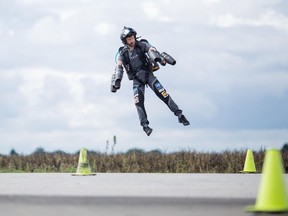The start-up is making inroads partnering with emergency responders and special military units.
Author of the article:
Washington Post
Pranshu Verma

Iron Man-style jetpacks are on the market — if you have about US$400,000 to spend.
Gravity, a human flight start-up out of the United Kingdom, demonstrated its latest suit — which straps onto the wearer’s back — at a trade show in Chicago last week. Founder Richard Browning, powered by gas turbine engines, flew 10 or 15 feet into the air, zooming around a grassy patch of land near a convention center.
From our newsroom to your inbox at noon, the latest headlines, stories, opinion and photos from the Toronto Sun.
Thanks for signing up!
A welcome email is on its way. If you don't see it, please check your junk folder.
The next issue of Your Midday Sun will soon be in your inbox.
Browning knows it’s unlikely that hordes of humans will be buzzing around in the air anytime soon — noting the company’s business model is still largely based on corporate and military demonstrations. It costs about $3,000 to test a suit for a few hours at one of the company’s flight centers.
Still, the start-up has amassed funding from some heavy hitters in the venture capital world and is making inroads partnering with emergency responders and special military units.
“Whether you believe in humans traveling like this in the future,” Browning said, “you can take a lot of almost sci-fi type . . . inspiration from what we’ve done.”
While the dream of flying with jetpacks is at least as old as “The Jetsons,” the technology has been developed in fits and starts over the past century. Only a handful of companies, such as Gravity and Jet Pack Aviation, are selling products on the market.
Jet Pack Aviation does not disclose pricing on its website but says a two-day training program in Southern California costs about $5,000.
It’s unclear what regulatory hurdles this type of technology might face if it attracted wide adoption. Some experts say delivery drones, for example, may never become a big part of the logistics network because of the complicated regulations governing their use – as well as the potential dangers of having too many buzzing around the skies.
Gravity said it does not fall into any aviation categories, so permissions aren’t required, but it works closely with regulators. On its website, Jet Pack Aviation says all of its U.S. flights are approved by the Federal Aviation Administration.
RECOMMENDED VIDEO
In 2017, Browning started Gravity near London and secured $650,000 from Adam and Tim Draper, venture capitalists known for early investments in China’s Baidu, Tesla and Skype. Since then, Gravity has tinkered with its jetpack design, making about 1,000 iterations of its 3D-printed jet suit.
The suit is powered by five gas turbine jet engines, which generate about 1,000 horsepower, according to the company. It weighs about 75 pounds with fuel in it. The suit can run on jet fuel, diesel or kerosene.
Users can direct the jetpack by moving their arms as if they’re leaning on a table. It has a top speed of 80 mph and is technically capable of reaching an altitude of 12,000 feet. The company, however, noted that the jetpack has been tested at lower heights for safety purposes.
The company has designed an electric version of the jet suit, which it demonstrated for Amazon founder Jeff Bezos in March. The batteries needed to power it are too heavy and make that version difficult to fly, Browning said. (Bezos owns The Washington Post.)
RECOMMENDED VIDEO
To make money, the company shows the suit at events across the globe, including at Bezos’s MARS conference and the opening of Japan’s baseball season. This year, Browning said, the company will have roughly $5 million in revenue, about $500,000 of which will be profit.
The company is partnering with a British air ambulance service to see if paramedics can don the suit to reach critically ill patients and stabilize them before emergency vehicles arrive. Seven special military units are exploring how to use the jetpack to help fighters in battlefield situations, such as outflanking an opponent or boarding a ship.
But the suit is unlikely to make it into the public domain anytime soon, Browning said.
“It would be like taking a NASCAR or Formula One car down to Walmart,” he said. “You could, but no one would.”


